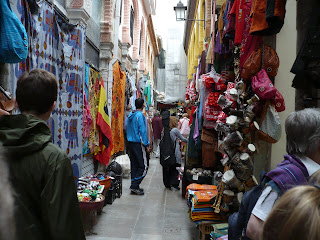About 40 minutes from us is a lovely little coastal town called “Nerja”, pronounced "Ner-ha". 
The Caves of Nerja were discovered in 1959 by five boys. They were exploring. As I walked through the amazing cavernous spaces I marveled at how courageous these boys must have been to come in. The caves go on and on for 5 km! Only a small section is open to the public. It has cement walkways and strategically placed lights in order to reflect the immense size and  dramatic stalactites and stalagmites. It has the largest cave form in the world inside, according to Guinness. It is a stalagmite/stalactite combo that is 32 metres in height and larger than an ancient Sequoia in girth.
dramatic stalactites and stalagmites. It has the largest cave form in the world inside, according to Guinness. It is a stalagmite/stalactite combo that is 32 metres in height and larger than an ancient Sequoia in girth.
 dramatic stalactites and stalagmites. It has the largest cave form in the world inside, according to Guinness. It is a stalagmite/stalactite combo that is 32 metres in height and larger than an ancient Sequoia in girth.
dramatic stalactites and stalagmites. It has the largest cave form in the world inside, according to Guinness. It is a stalagmite/stalactite combo that is 32 metres in height and larger than an ancient Sequoia in girth. They’ve found evidence of human occupation from the Neolithic age and research is presently underway. There are paintings, fragments of tools and human remains. It is supposed that the caves were known for thousands of years before they fell out of use. What an incredible find for the boys! 

One of the boys is still around. He runs an eatery on the big beach in Nerja. He is something of a local celebrity and has a larger than life personality. He became an athlete for awhile and then started this restaurant which hires “difficult to hire” people. We spent a second day in Nerja to partake of the paella feast he serves up at his beachside restaurant. The food was wonderful and watching them make it was even more fun.

They have a huge round cast iron pan over a roaring fire. They throw in a LOT of uncooked rice, and cooked chicken/seafood bits. They stir this up a bit and then add a large pail of murky looking water. The water must have a lot of spices in it because if not, it was probably not a good idea to have eaten there. The pan bubbles wetly and every so often, various men stir it up with a long stick. After they deem it cooked, two men heave it from the fire to place it on the cooling rack where it sits for ten minutes or so. The chef periodically comes b y to spoon a bit near the edge.
y to spoon a bit near the edge.
 y to spoon a bit near the edge.
y to spoon a bit near the edge. Finally, he begins serving it onto plates. He just continues to spoon out generous portions until the whole pan is empty. All the food disappears as fast as he can serve. We figured it must be “all you can eat” because several diners went back for more. I don’t know HOW they could have still been hungry as I couldn’t even finish my first portion. Paella was a dish the poor farmers used to eat. It was first produced in Valencia and spread throug hout Spain because it was easy, cheap and filling. I can’t imagine the poor farmers had quite as much meat in their paella, though.
hout Spain because it was easy, cheap and filling. I can’t imagine the poor farmers had quite as much meat in their paella, though.
 hout Spain because it was easy, cheap and filling. I can’t imagine the poor farmers had quite as much meat in their paella, though.
hout Spain because it was easy, cheap and filling. I can’t imagine the poor farmers had quite as much meat in their paella, though. The meal was delicious with lots of chicken, prawns, clams and maybe scallops but they weren’t in the shell so we weren’t completely sure. Most of the seafood chunks were the whole critter which made eating them tricky. One prawn on my plate was so large we weren’t sure if it was a prawn or not!
 After lunch, we rolled our bloated selves onto the beach and lounged along with the rest of Northern Europe. It was fun listening to the wide variety of languages spoken around us. The Scandinavian group nearby seemed like fun and I thought it was a shame we didn’t speak their language. Mind you, add a never-ending flow of beer to any group and I suppose they’ll be fun. The water was cold but many people still went swimming because it was hot. Julia joined the ranks and took her first swim of the year. The rest of us chose to wait. We may not have long to wait though, because the weather ha
After lunch, we rolled our bloated selves onto the beach and lounged along with the rest of Northern Europe. It was fun listening to the wide variety of languages spoken around us. The Scandinavian group nearby seemed like fun and I thought it was a shame we didn’t speak their language. Mind you, add a never-ending flow of beer to any group and I suppose they’ll be fun. The water was cold but many people still went swimming because it was hot. Julia joined the ranks and took her first swim of the year. The rest of us chose to wait. We may not have long to wait though, because the weather ha s definitely taken a turn for the hot. It was 30 degrees on the beach!
s definitely taken a turn for the hot. It was 30 degrees on the beach! 









